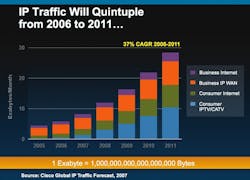Advantages of Wireless Extend Beyond Fast Access
Many property owners and managers are discovering that legacy communications infrastructures simply cannot handle modern bandwidth demands: Today, five video websites generate more Internet traffic than the entire U.S. backbone did in 2000.
"Our nation's workers are pushing through massive quantities of data, and it's growing exponentially with technologies like videoconferencing," says Rick Huijbregts, strategy and development manager for San Jose, CA-based Cisco Systems Inc. "Add next-gen workers to that, who have grown up in the Internet Age, and it becomes clear that fiber-optic and wireless technologies are the solution for improving capacity."
The differences between old technologies and new are profound, with vast improvements in capabilities and speeds up to 1,000-times faster than T1 connections. But, the benefits extend far beyond speed.
Perhaps most significant are the fire-/life-safety benefits: Wireless and distributed antennae systems mean clear signals between rescue workers inside and battalion chiefs outside. In smart buildings, where all building systems are integrated, it can mean that, from a laptop outside, fire personnel could see which alarm triggered, open applicable surveillance video, and shut down elevators—all before going inside.
"We offer wireless for multiple reasons," says Tommy Russo, director of technology at Akridge, a Washington, D.C.-based commercial real estate firm, "but life safety is first and foremost. We were just given a 7.5-percent discount off of our insurance; it really puts a price on return on investment."
For tenants and their guests, wireless connectivity means cell-phone coverage and Internet access everywhere—stairwells, elevators, and garage included—and no need to cluster near windows searching for a signal or crawl on the floor looking for a phone line. At Akridge, going wireless enabled the set-up of wireless surveillance cameras and the conversion of an outdated directory into a digital sign with video and touchscreen technology.
Workflow between tenants and landlords can also be vastly improved, with self-service websites enabling the transfer of electronic funds and work-order submissions 24/7. That kind of immediacy can streamline facility-management operations. At San Diego-based SENTRE Partners, a Web-based work-order system utilizing a wireless infrastructure allows building engineers to carry Web tablets and pocket PCs so they can open and close tenant work orders on the spot.
Cost of installation is thankfully no deterrent: According to Matt Spathas, partner at SENTRE Partners and CEO at San Diego-based Bandwidth Now, an all-optical network will typically range between $1 and $1.25 per square foot—a fraction of the cost of electricity, gas, and water networks, which can run $20 per square foot.
In spite of these advantages, most tenants are not yet making leasing decisions based solely on a building's technological amenities, and property owners may mistakenly believe it's a trend that can be placed on the backburner.
"Tenants aren't necessarily demanding wireless connectivity ... but, once they experience it, they can't do without it," says Spathas. "In fact, 80 to 90 percent of our tenants move to their building's broadband package once their contracts with other carriers expire."
Stephanie J. Oppenheimer, former assistant vice president of communications at BOMA Intl., is principal at Skylite Communications, based in Falls Church, VA.

